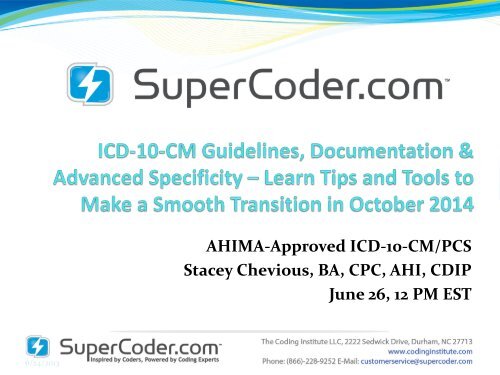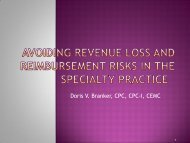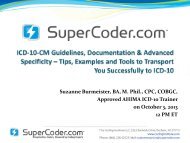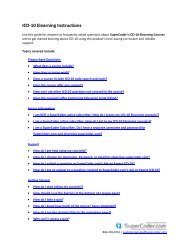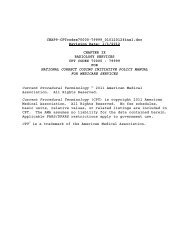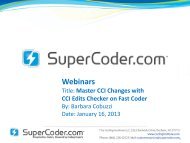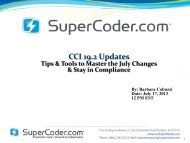ICD-10 guide - SuperCoder
ICD-10 guide - SuperCoder
ICD-10 guide - SuperCoder
You also want an ePaper? Increase the reach of your titles
YUMPU automatically turns print PDFs into web optimized ePapers that Google loves.
AHIMA-Approved <strong>ICD</strong>-<strong>10</strong>-CM/PCS<br />
Stacey Chevious, BA, CPC, AHI, CDIP<br />
June 26, 12 PM EST<br />
6/24/2013
Agenda<br />
• Get an overview of <strong>ICD</strong>-<strong>10</strong> – including glimpses into the major ways <strong>ICD</strong>-<strong>10</strong> is very<br />
different from <strong>ICD</strong>-9<br />
• Prepare for code documentation requirement changes<br />
• Tackle the advanced specificity and the stronger clinical knowledge requirements that<br />
will be necessary for proper selection of <strong>ICD</strong>-<strong>10</strong>-CM code sets<br />
• Make documentation improvements now - like teaching cardiologists to be specific as<br />
they identify each vein<br />
• Use <strong>ICD</strong>-<strong>10</strong>-CM to identify the appropriate diagnoses<br />
• Easily convert <strong>ICD</strong>-9-CM codes to <strong>ICD</strong>-<strong>10</strong>-CM with two mappers, including CMS GEMs<br />
and <strong>SuperCoder</strong>'s Extended Logic bridge to ensure you find the most appropriate code<br />
• Focus on the <strong>ICD</strong>-<strong>10</strong>-CM changes that most affect your specialty<br />
• Discover the impact <strong>ICD</strong>-<strong>10</strong>-CM will have on your billing and software systems and keep<br />
the payments coming in<br />
• Determine whether you should report multiple codes or a single <strong>ICD</strong>-<strong>10</strong>-CM code<br />
• Condense top used <strong>ICD</strong>-<strong>10</strong> diagnoses into manageable-sized superbills.<br />
6/24/2013<br />
2
6/24/2013<br />
3
Biggest Change in Three Decades – are you<br />
equipped for it?<br />
<strong>ICD</strong>-<strong>10</strong> is the biggest change in medical coding in close to<br />
three decades - with diagnosis codes increasing from 14,000<br />
to 69,000! The countdown to this system stands at just over a<br />
year, so now is a great time to take a break from focusing on<br />
new diagnosis codes and zero in on the transition details your<br />
practice needs to know.<br />
6/24/2013<br />
4
<strong>ICD</strong>-<strong>10</strong> Jitters?<br />
As the implementation day inches closer, you could be asking yourself:<br />
• Will you be ready by October 1, 2014?<br />
• Should you wait until October 1, 2014 to use <strong>ICD</strong>-<strong>10</strong>?<br />
• How to prepare for documentation changes and improvements with<br />
<strong>ICD</strong>-<strong>10</strong>?<br />
• What’s the difference between <strong>ICD</strong>-9-CM and <strong>ICD</strong>-<strong>10</strong>-CM besides<br />
‘more room’ and greater specificity?<br />
• How to tackle the high level of specificity that the new system will<br />
bring to your work?<br />
• How will this implementation impact my job?<br />
6/24/2013<br />
5
Don’t worry! That’s why <strong>SuperCoder</strong> is here<br />
today – to ease your <strong>ICD</strong>-<strong>10</strong> concerns!<br />
<strong>SuperCoder</strong> combines online, print, live and audio training on <strong>ICD</strong>-<strong>10</strong><br />
that focuses on each individual’s/practice’s/organization’s needs in order<br />
to reduce training time and cost. Our <strong>ICD</strong>-<strong>10</strong> editors are AHIMA certified<br />
and have worked with national consultants.<br />
6/24/2013<br />
6
What to Expect in 2014<br />
Advanced Specificity<br />
<strong>ICD</strong>-<strong>10</strong>-CM requires much greater detail to determine the proper<br />
diagnoses than <strong>ICD</strong>-9. A more thorough understanding of anatomy and<br />
physiology is required for this new code set.<br />
Example: A physician treats a patient for a lower back pressure ulcer.<br />
<strong>ICD</strong>-9: You should report 707.03 (Pressure ulcer; lower back) and an<br />
additional code from 707.20-707.25 (Pressure ulcer stages ...) to identify<br />
the pressure ulcer stage.<br />
6/24/2013<br />
7
Gear up for Advanced Specificity<br />
• 707.20 -- Pressure ulcer, unspecified stage<br />
• 707.21 -- Pressure ulcer stage I<br />
• 707.22 -- Pressure ulcer stage II<br />
• 707.23 -- Pressure ulcer stage III<br />
• 707.24 -- Pressure ulcer stage IV<br />
• 707.25 -- Pressure ulcer, unstageable<br />
Note: Descriptor specifies the stage.<br />
<strong>ICD</strong>-<strong>10</strong> Changes:<br />
1. The example does not include enough information. You need to know<br />
whether the ulcer is on the left or right.<br />
2. You'll report a single code. Some options will be (but are not limited to):<br />
L89.131 (Pressure ulcer of right lower back, stage I) L89.141 (Pressure ulcer<br />
of left lower back, stage I).<br />
6/24/2013<br />
8
Bottom line: You’ll need additional anatomic details when you start<br />
using <strong>ICD</strong>-<strong>10</strong>.<br />
Example: For the same lower back pressure ulcer, the proper <strong>ICD</strong>-<strong>10</strong> code<br />
will depend on whether the ulcer is on the left or right.<br />
Nuggets:<br />
1. Body side information didn’t matter for <strong>ICD</strong>-9. But <strong>ICD</strong>-<strong>10</strong> will allow you to<br />
be more specific.<br />
2. Rather than using two codes as you do under <strong>ICD</strong>-9, a single <strong>ICD</strong>-<strong>10</strong> code<br />
will represent both the anatomic location and the stage.<br />
•Examples: L89.131 (Pressure ulcer of right lower back, stage I) or L89.141 (Pressure ulcer of<br />
left lower back, stage I).<br />
6/24/2013<br />
9
3 Changes for Coding Conventions<br />
While many coding conventions will remain the same as you make the<br />
transition, you'll need to be aware of a few crucial differences for accurate<br />
reporting.<br />
1. Excludes May Mean Two Different Things<br />
One major change is that <strong>ICD</strong>-<strong>10</strong> has two different types of "excludes"<br />
notes. While this might seem like another layer of complication in<br />
coding, it will actually clear up one of <strong>ICD</strong>-9's little quirks.<br />
6/24/2013<br />
<strong>10</strong>
<strong>ICD</strong>-9 Versus <strong>ICD</strong>-<strong>10</strong><br />
2. 'X' Marks the Spot<br />
When you receive your <strong>ICD</strong>-<strong>10</strong> manual, you may see certain codes that<br />
include an "x" or an "x?" in them -- but don't chalk it up to a printing<br />
error. The "x" in your code listing is actually there to help you.<br />
3. Keep An Eye (And Ear, Etc.) on Laterality<br />
You may have heard news about the <strong>ICD</strong>-<strong>10</strong> manual being<br />
substantially thicker, but don't be alarmed -- much of the book's<br />
additions are merely due to the fact that many codes will require you<br />
to denote whether the left side or right side was treated when dealing<br />
with certain anatomic areas (eyes, ears, hands, hands, feet, ovaries,<br />
etc.)<br />
6/24/2013<br />
11
What's the difference between <strong>ICD</strong>-9 and <strong>ICD</strong>-<strong>10</strong><br />
besides 'more room' and greater specificity?<br />
• <strong>ICD</strong>-<strong>10</strong> codes are alpha numeric and up to seven characters in length;<br />
<strong>ICD</strong>-9 codes are only three to five characters.<br />
• <strong>ICD</strong>-<strong>10</strong>-CM has 21 chapters; <strong>ICD</strong>-9 has 17.<br />
• <strong>ICD</strong>-9-CMs V and E codes are incorporated into the main classification<br />
in the <strong>ICD</strong>-<strong>10</strong>-CM code:<br />
• Placeholders (X) are required to hold places followed by<br />
additional characters.<br />
• Seventh characters are required for obstetrics, injuries, and<br />
external causes of injuries.<br />
• Post-operative complications will now be located specific to<br />
the procedure-specific body system.<br />
6/24/2013<br />
12
<strong>ICD</strong>-<strong>10</strong> Versus <strong>ICD</strong>-9<br />
• <strong>ICD</strong>-<strong>10</strong> will classify injuries first by<br />
specific site and then by type of<br />
injury. <strong>ICD</strong>-9 classified injuries by<br />
type.<br />
• <strong>ICD</strong>-<strong>10</strong>-CM includes full code<br />
titles for all codes, so it’s not<br />
necessary to reference back to<br />
common fourth and fifth digit<br />
categories.<br />
• Combination codes for conditions<br />
and common symptoms or<br />
manifestations, for example E<strong>10</strong>.21.<br />
6/24/2013<br />
13
Bilateral Sites<br />
For bilateral sites, you'll find a final character in the codes in which <strong>ICD</strong>-<br />
<strong>10</strong> specifies the side or both sides as follows:<br />
Anatomic Detail Character Digit<br />
Right side 1<br />
Left side 2<br />
Bilateral 3<br />
Example: A physician sees a patient for a follow-up visit in which she<br />
examines an abscess of a bursa on the right wrist. You should report<br />
M71.031. Notice how the last digit is "1." If this was for the left wrist, you<br />
would report M71.032.<br />
6/24/2013<br />
14
<strong>ICD</strong>-<strong>10</strong> Tips & Strategies for a Smooth Transition<br />
What can you and your practice do to get ready for the conversion?<br />
One thing you won't need to do is remember a bunch of new codes.<br />
Do this:<br />
Look at the codes that you most often use in your practice. Labs and<br />
pathologists should pick the top 30 diagnoses that they see and<br />
concentrate on knowing how to code those appropriately. Then you<br />
should create new job aids or requisitions for those procedures.<br />
6/24/2013<br />
15
Strategy:<br />
• Use your list of the top diagnoses that your lab sees to find the<br />
corresponding <strong>ICD</strong>-<strong>10</strong> codes, and you've got your cheat sheet.<br />
• Ensure that your coders are trained, your claims are form 50<strong>10</strong><br />
compliant, and your claim submission system supplier is <strong>ICD</strong>-<strong>10</strong>-ready.<br />
• If you have an EMR or plan to get one, make sure it can handle <strong>ICD</strong>-<strong>10</strong>.<br />
If you're starting to bring in an EMR, you want to convert to <strong>ICD</strong>-<strong>10</strong><br />
first, not bring one in under <strong>ICD</strong>-9 and then convert.<br />
6/24/2013<br />
16
Think All <strong>ICD</strong>-9 Codes Expand into Multiple<br />
Choices in 2014? Think Again<br />
Here's how you should report conditions both acute and chronic.<br />
You incorrectly may assume that <strong>ICD</strong>-9 codes will always multiply into<br />
more specific options, and that's why the <strong>ICD</strong>-<strong>10</strong>-CM manual is so big.<br />
However, that isn't always the case. Conditions requiring two or more<br />
<strong>ICD</strong>-9 codes right now might be simplified into a single <strong>ICD</strong>-<strong>10</strong> option in<br />
2014.<br />
Best bet: To determine whether you should report multiple codes or a<br />
single <strong>ICD</strong>-<strong>10</strong> code, read coding <strong>guide</strong>lines. Keep an eye out for phrases<br />
like "use additional code" or "code first."<br />
6/24/2013<br />
17
Stress-Free Switch to the New System<br />
You don’t have to be overwhelmed!<br />
<strong>SuperCoder</strong> is here to help with your <strong>ICD</strong>-<strong>10</strong> transition by providing and<br />
tools to learn <strong>ICD</strong>-<strong>10</strong>-CM <strong>guide</strong>lines, documentation and advanced<br />
specificity!<br />
6/24/2013<br />
18
<strong>ICD</strong>-<strong>10</strong> Products on <strong>SuperCoder</strong><br />
<strong>SuperCoder</strong>’s All-Encompassing <strong>ICD</strong>-<strong>10</strong> products include:<br />
Web-based coding tools and newsletter:<br />
• <strong>ICD</strong>-<strong>10</strong> Coder includes:<br />
1. <strong>ICD</strong>-<strong>10</strong> Code Search<br />
2. <strong>ICD</strong>-<strong>10</strong> Coding Alert<br />
3. <strong>ICD</strong>-<strong>10</strong> Bridges<br />
‣ Every <strong>SuperCoder</strong> “Code Search” product includes <strong>ICD</strong>-<strong>10</strong> Code/Keyword<br />
Lookup, Index, and Tables (and <strong>ICD</strong>-9 too!)<br />
E-Learning:<br />
• <strong>ICD</strong>-<strong>10</strong> Coder Practical Applications<br />
• <strong>ICD</strong>-<strong>10</strong> <strong>SuperCoder</strong> Anatomy & Pathophysiology<br />
• <strong>ICD</strong>-<strong>10</strong> Specialty Top Diagnoses<br />
• <strong>ICD</strong>-<strong>10</strong> Coder’s Total Prep Pack<br />
6/24/2013<br />
19
<strong>ICD</strong>-<strong>10</strong> Coder: Online Code Look Up & Advice<br />
6/24/2013
<strong>ICD</strong>-<strong>10</strong> Coder Essentials:<br />
• Streamlined Search: Lookup any <strong>ICD</strong>-<strong>10</strong>-CM, CPT®, <strong>ICD</strong>-9-CM, or<br />
HCPCS code and view the essential information on 1 page, including<br />
official descriptor, CPT-<strong>ICD</strong>-9 CrossRef, and mapper<br />
• <strong>ICD</strong>-<strong>10</strong> Coding Alert: Every month, get step-by-step, accurate,<br />
authoritative <strong>ICD</strong>-<strong>10</strong> guidance from AHIMA certified <strong>ICD</strong>-<strong>10</strong> coding<br />
instructor Suzanne Leder, CPC, COBGC<br />
• <strong>ICD</strong>-<strong>10</strong> Bridges: Easily convert <strong>ICD</strong>-9-CM codes to <strong>ICD</strong>-<strong>10</strong>-CM with 2<br />
<strong>ICD</strong>-<strong>10</strong> mappers, including CMS GEMs and our unique extended<br />
bridge<br />
• Increased Compliance: Check allowed modifiers, associated drugs,<br />
CCI edits, and more all at code level<br />
• 38 AAPC-Approved CEUS, 5 AHIMA-Approved CEUS: Maintain your<br />
certifications with a list of CEU opportunities included in your<br />
subscription<br />
6/24/2013
<strong>ICD</strong>-<strong>10</strong> Code Search<br />
<strong>SuperCoder</strong>.com provides a reliable source of <strong>ICD</strong>-9 and <strong>ICD</strong>-<strong>10</strong> coding<br />
information, including a user-friendly search format already employed<br />
by more than <strong>10</strong>,000 subscribers.<br />
The online nature of <strong>SuperCoder</strong>.com allows multiple users from a<br />
single organization to search the code sets at the same time.<br />
The code search function enables you to search by code set (e.g., <strong>ICD</strong>-9,<br />
<strong>ICD</strong>-<strong>10</strong>, or both), by a code’s digits/characters, or by the code<br />
description, including related keywords. The search box features an<br />
autosuggest function to increase user productivity by reducing the<br />
number of keystrokes required to search for the proper code. The<br />
related codeset's index terms are included in the autosuggest so that<br />
the user has the benefit of official terminology. See the screenshot<br />
below for an example.<br />
6/24/2013
Code Search<br />
6/24/2013
Search Results:<br />
After you enter the search criteria and perform the search, the<br />
<strong>SuperCoder</strong>.com search results appear in an easy-to-review format. You<br />
have the option of seeing results from:<br />
<strong>ICD</strong>-9 and <strong>ICD</strong>-<strong>10</strong> indexes<br />
index tables<br />
<strong>SuperCoder</strong>.com’s search logic<br />
Or all of them at the same time<br />
<strong>SuperCoder</strong>'s extensive vocabulary allows the user to benefit from<br />
additional abbreviations and terms not included in the codeset's index<br />
that are commonly used in medical documentation. Additionally, users<br />
may sort the results by numeric order rather than weighted logic that<br />
places more commonly used codes higher in the results' list.<br />
6/24/2013
<strong>SuperCoder</strong>'s Color-coded Search Results Reveal the<br />
Definitive Source of the Results<br />
6/24/2013
<strong>ICD</strong>-<strong>10</strong> Coding Alert<br />
In <strong>ICD</strong>-<strong>10</strong>, payers will reimburse based on the specificity of the diagnosis<br />
code chosen – unlike now. This is where proper documentation comes<br />
into play – the more detailed the documentation – the more specific the<br />
<strong>ICD</strong>-<strong>10</strong> codes chosen – and in turn providers will realize their full<br />
reimbursement.<br />
This is where our monthly newsletter - <strong>ICD</strong>-<strong>10</strong> Coding Alert – can<br />
help by providing:<br />
• <strong>ICD</strong>-<strong>10</strong> training and documentation strategies<br />
• Specific examples to help you apply <strong>ICD</strong>-<strong>10</strong> coding <strong>guide</strong>lines<br />
• Advice on converting your <strong>ICD</strong>-9 superbills to <strong>ICD</strong>-<strong>10</strong> superbills<br />
Every month, AHIMA-approved <strong>ICD</strong>-<strong>10</strong> instructor, Suzanne Leder,<br />
CPC, COBGC will provide expert insight to overcome your toughest<br />
<strong>ICD</strong>-<strong>10</strong> coding, documentation and reimbursement questions.<br />
6/24/2013<br />
26
<strong>ICD</strong>-<strong>10</strong> Coding Alert – monthly newsletter<br />
Here’s just a sample of the expert insight you’ll get every month:<br />
• New <strong>ICD</strong>-<strong>10</strong> coding conventions to factor into your training<br />
• Documenting completely so that <strong>ICD</strong>-<strong>10</strong> codes can be chosen at the highest<br />
level of specificity<br />
• What are some of the audit blunders practices may find themselves in when<br />
going through a review of their documentation, compared to the <strong>ICD</strong>-<strong>10</strong> code<br />
chosen?<br />
• Specifics on a variety of top diagnoses and how they will change<br />
• Get ready for NCD changes to Parallel <strong>ICD</strong>-<strong>10</strong> implementation<br />
• Diagnosis Spotlight: Get set for broader reporting options for acute respiratory<br />
failure<br />
• How to go about getting our providers’ documentation ready for the transition<br />
from <strong>ICD</strong>-9 to <strong>ICD</strong>-<strong>10</strong><br />
• Treat "Unspecified" viral infection Dx carefully – you may have a better choice<br />
6/24/2013<br />
27
With <strong>ICD</strong>-<strong>10</strong> Coding Alert you also get:<br />
• Archived Library of Keyword and Code Searchable Articles on <strong>ICD</strong>-<strong>10</strong><br />
• Reader Questions on Tough <strong>ICD</strong>-<strong>10</strong> Scenarios<br />
• Possible 24 AAPC and 5 AHIMA CEUs<br />
• Free Bi-Weekly Newsletter <strong>SuperCoder</strong> Bolt<br />
6/24/2013<br />
28
Example<br />
Currently when you report acute atopic conjunctivitis, you report 372.05<br />
(Acute atopic conjunctivitis). In the rare cases when insurers want to<br />
know which eye was affected, you append the right side (RT) or left side<br />
(LT) modifiers.<br />
<strong>ICD</strong>-<strong>10</strong> changes:<br />
1. Denote the specific type of conjunctivitis by using the accurate<br />
diagnosis code.<br />
2. Indicate which eye was affected.<br />
Example: An acute atopic conjunctivitis diagnosis could track to one of<br />
the following codes, depending on the eye affected:<br />
6/24/2013<br />
29
• H<strong>10</strong>.<strong>10</strong> -- Acute atopic conjunctivitis, unspecified eye<br />
• H<strong>10</strong>.11 -- Acute atopic conjunctivitis, right eye<br />
• H<strong>10</strong>.12 -- Acute atopic conjunctivitis, left eye<br />
• H<strong>10</strong>.13 -- Acute atopic conjunctivitis, bilateral<br />
Documentation: Your physicians should already be including the<br />
affected eye in their documentation.<br />
Action: Format the superbill to capture the additional anatomical<br />
information.<br />
6/24/2013<br />
30
<strong>ICD</strong>-<strong>10</strong> Bridges: Easily Crosswalk to 2014 System<br />
You can easily learn the <strong>ICD</strong>-<strong>10</strong> codes you'll use in place of your<br />
commonly used <strong>ICD</strong>-9 codes with <strong>SuperCoder</strong>'s two <strong>ICD</strong>-<strong>10</strong> code<br />
mappers. The Bridges allow you to translate <strong>ICD</strong>-9-CM codes to <strong>ICD</strong>-<br />
<strong>10</strong>-CM codes, or vice versa.<br />
Here's just a sample of how you can use these <strong>ICD</strong>-<strong>10</strong> Bridges:<br />
• Convert your <strong>ICD</strong>-9 superbills to <strong>ICD</strong>-<strong>10</strong> superbills<br />
• Managers: Identify <strong>ICD</strong>-<strong>10</strong> code specifics you want to include in your<br />
system<br />
• For payers: Back walk a provider supplied <strong>ICD</strong>-<strong>10</strong> code into the <strong>ICD</strong>-9<br />
accepted version<br />
• All: Mix and match <strong>ICD</strong>-<strong>10</strong> code implementation approaches to best<br />
fit your needs<br />
• Get the <strong>ICD</strong>-9 and <strong>ICD</strong>-<strong>10</strong> 2012 code official definitions in seconds<br />
6/24/2013
<strong>ICD</strong>-<strong>10</strong> Bridges<br />
Here’s an example of the search for <strong>ICD</strong>-9 fever code 780.60. Note that<br />
the results (bottom left) are links so that you can go directly to the<br />
code’s details page. Also, just above the orange “Lookup” box, you may<br />
select whether to search from <strong>ICD</strong>-9 to <strong>ICD</strong>-<strong>10</strong> or from <strong>ICD</strong>-<strong>10</strong> to <strong>ICD</strong>-<br />
9. The current <strong>ICD</strong>-<strong>10</strong>-CM official <strong>guide</strong>lines are also conveniently<br />
available from this page.<br />
6/24/2013
<strong>SuperCoder</strong>’s <strong>ICD</strong>-<strong>10</strong> E-Learning<br />
Curriculum for Seamless,<br />
Money-Saving Conversion<br />
6/24/2013<br />
33
Self-Paced E-Learning Products<br />
<strong>SuperCoder</strong>’s <strong>ICD</strong>-<strong>10</strong> E-Learning Curriculum lets non-coders, coders, billers,<br />
and physicians take only the lessons they need. In an industry short on staffing<br />
and financial resources, you need a training solution that gets every member of<br />
your team from CS to data entry to clinicians up to speed without costing too<br />
much or taking too long. Our E-Learning curriculum appeal to:<br />
• <strong>ICD</strong>-<strong>10</strong> Coder Practical Applications - AAPC or AHIMA certified<br />
coder or a noncertified coder, billers, IT, CS, management<br />
• <strong>ICD</strong>-<strong>10</strong> Supercoder Anatomy & Pathophysiology - providers,<br />
coders, coding and documentation educators<br />
• <strong>ICD</strong>-<strong>10</strong> Specialty Top Diagnoses - providers, coders, coding and<br />
documentation educators, office managers, noncertified coders<br />
• <strong>ICD</strong>-<strong>10</strong> Coder's Total Prep Pack - providers, coders, coding and<br />
documentation educators<br />
6/24/2013<br />
34
‣<strong>ICD</strong>-<strong>10</strong> Coder Practical Applications<br />
<strong>SuperCoder</strong>'s <strong>ICD</strong>-<strong>10</strong> Coder Practical Applications E-Learning<br />
focused on only the elements you need saves you time and money. Get the<br />
knowledge from basics to coding <strong>guide</strong>lines to ensure continued<br />
certification and pay using <strong>ICD</strong>-<strong>10</strong>-CM.<br />
Benefits:<br />
• Straightforward guidance on the essential <strong>ICD</strong>-<strong>10</strong> points makes<br />
tackling the new system doable<br />
• Tons of examples bring <strong>ICD</strong>-<strong>10</strong> to live<br />
• Concise sections make getting the facts quick and fun<br />
• Plain English explanations help you understand the <strong>ICD</strong>-<strong>10</strong> coding<br />
system fundamentals<br />
• Discover the impact <strong>ICD</strong>-<strong>10</strong> will have on your billing and software<br />
systems to keep payment streaming in<br />
6/24/2013<br />
35
Quick-view dashboard so you see your progress:<br />
6/24/2013<br />
36
Details:<br />
• 1-year access for on-going reference and guidance<br />
• Includes immediate class support from <strong>ICD</strong>-<strong>10</strong> trainers via e-mail<br />
• Written by the trusted Coding Institute experts who have been<br />
providing education since 1947<br />
• Chapter quizzes test your comprehension<br />
• 6 concise chapters dig into <strong>ICD</strong>-<strong>10</strong> structure, coding <strong>guide</strong>lines, GEMs<br />
and more<br />
6/24/2013<br />
37
Basics:<br />
Gain awareness of <strong>ICD</strong>-<strong>10</strong>-CM history, applicability, implementation<br />
techniques, and learning methodology. Topics covered include:<br />
• Why should I learn <strong>ICD</strong>-<strong>10</strong> now?<br />
• Brief History of <strong>ICD</strong><br />
• Who else is using <strong>ICD</strong>-<strong>10</strong>?<br />
• Why is <strong>ICD</strong>-9-CM Changing?<br />
• What's so great about <strong>ICD</strong>-<strong>10</strong>-CM?<br />
• What's the difference between <strong>ICD</strong>-9-CM and <strong>ICD</strong>-<strong>10</strong>-CM besides<br />
'more room' and greater specificity?<br />
• What do I not have to re-learn for <strong>ICD</strong>-<strong>10</strong>-CM?<br />
• What should I do with these <strong>ICD</strong>-<strong>10</strong> basics?<br />
• Basics CEU Quiz-<strong>ICD</strong>-<strong>10</strong> <strong>guide</strong><br />
6/24/2013<br />
38
Billing and Technology<br />
This section teaches you about various billing and technology<br />
requirements in context to the <strong>ICD</strong>-<strong>10</strong>-CM conversion. Topics covered<br />
include:<br />
• Version 50<strong>10</strong><br />
• Claims Processing<br />
• Dual Claims Processing<br />
• Technology<br />
• Electronic Medical Records (EMR)<br />
• Billing and Technology CEU Quiz-<strong>ICD</strong>-<strong>10</strong> <strong>guide</strong><br />
6/24/2013<br />
39
Structure and Organization<br />
Start looking up <strong>ICD</strong>-<strong>10</strong> codes with the tools you need included in this section.<br />
Come away with understanding the layout of <strong>ICD</strong>-<strong>10</strong>-CM, the number of codes<br />
the system carries, the structure of these codes, the navigation techniques, and<br />
critical code conventions. You'll get the answers to:<br />
• How many codes are in the <strong>ICD</strong>-<strong>10</strong>-CM coding manual?<br />
• What will my first character be?<br />
• How many characters can an <strong>ICD</strong>-<strong>10</strong>-CM code have?<br />
• Will my <strong>ICD</strong>-<strong>10</strong>-CM manual be hard to navigate?<br />
• How does the <strong>ICD</strong>-<strong>10</strong>-CM Alphabetic Index differ?<br />
• Will I discover any changes to the Tabular List?<br />
• How do I navigate the code categories in the Tabular List?<br />
• What <strong>ICD</strong>-<strong>10</strong>-CM code conventions do I need to know?<br />
• Are the "Notes" different in <strong>ICD</strong>-<strong>10</strong>-CM?<br />
• Structure and Organization CEU Quiz-<strong>ICD</strong>-<strong>10</strong> <strong>guide</strong><br />
6/24/2013<br />
40
GEMs<br />
Explore Medicare's code mapping resource commonly known as the<br />
GEMs that providers, health information vendors, and payers can use to<br />
derive their <strong>ICD</strong>-<strong>10</strong> codes for some <strong>ICD</strong>-9 codes. Plus, be able to identify<br />
the differences between <strong>ICD</strong>-9-CM and <strong>ICD</strong>-<strong>10</strong>-CM/PCS. Topics covered<br />
include:<br />
• What are GEMs?<br />
• Are GEMs a true crosswalk?<br />
• What are the GEMs relationships like?<br />
• What key terms should you know?<br />
• What is an example of a GEM?<br />
• What do the flags mean?<br />
• Approximate Flag<br />
• No Map Flag<br />
• Combination Flag<br />
• Scenario Flag<br />
• Choice Flag<br />
• What should you do with<br />
this GEMs knowledge?<br />
• GEMs CEU Quiz-<strong>ICD</strong>-<strong>10</strong><br />
<strong>guide</strong><br />
6/24/2013<br />
41
Coding Guidelines<br />
Go in-depth into <strong>ICD</strong>-<strong>10</strong>'s coding <strong>guide</strong>lines. These section-specific rules<br />
are essential for correct coding and often hold critical information<br />
beyond a code's description. Topics covered include:<br />
• Acquaint Yourself With All <strong>ICD</strong>-<strong>10</strong>-CM Codes<br />
• Check Your Code Characters<br />
• Capture Single Condition With Multiple Codes<br />
• Report Multiple Conditions With Single Code<br />
• Delve Into Late Effects (Sequela)<br />
• Don't Let Threatened Conditions Go Unnoticed<br />
• Can You Report Same Diagnosis More Than Once?<br />
• Choose Your Side(s): Laterality in <strong>ICD</strong>-<strong>10</strong>-CM<br />
• More Documentation Issues: BMI and Pressure Ulcer Stages<br />
• Coding Guidelines CEU Quiz-<strong>ICD</strong>-<strong>10</strong> <strong>guide</strong><br />
6/24/2013<br />
42
References<br />
The <strong>ICD</strong>-<strong>10</strong>-CM references is a quick list to get you to definitive resources<br />
for further <strong>ICD</strong>-<strong>10</strong> exploration.<br />
6/24/2013<br />
43
‣<strong>ICD</strong>-<strong>10</strong> Anatomy & Pathophysiology<br />
<strong>ICD</strong>-<strong>10</strong> correct coding requires increased anatomical knowledge.<br />
You'll need additional anatomic details when you start using <strong>ICD</strong>-<strong>10</strong>. For<br />
instance, for the same lower back pressure ulcer, choosing the proper<br />
<strong>ICD</strong>-<strong>10</strong> code will depend on whether the ulcer is on the left or right. Did<br />
your physician probably already document this? Yes. That information<br />
didn't matter for <strong>ICD</strong>-9. But <strong>ICD</strong>-<strong>10</strong> will allow you to be more specific.<br />
Did you know?<br />
There may be an expected 20% increase in the time required for<br />
physician documentation to produce the specificity required in<br />
<strong>ICD</strong>-<strong>10</strong>.<br />
6/24/2013<br />
44
Anatomy Skills Key to <strong>ICD</strong>-<strong>10</strong>-CM Success<br />
Orthopedists, obstetricians, cardiology – where cardiologists, for<br />
instance need to be specific as they identify each vein – will be<br />
particularly impacted, triggering more room for confusion and<br />
payment denials!<br />
While everyone related to healthcare must know the new codes,<br />
physicians will have to be particularly well-versed with their own<br />
specialties and <strong>ICD</strong>-<strong>10</strong> and document with a sharper focus.<br />
6/24/2013<br />
45
Reimbursements at stake?<br />
Drawings, MD Insight Improve Comprehension.<br />
Teaching your provider to include one detail in his hip fracture<br />
documentation now can make the difference between a hard-to-get<br />
covered nonspecified <strong>ICD</strong>-<strong>10</strong> code or a direct-pay specified <strong>ICD</strong>-<strong>10</strong> code.<br />
Fortunately, <strong>SuperCoder</strong>’s <strong>ICD</strong>-<strong>10</strong> Anatomy &<br />
Pathophysiology enhances your <strong>ICD</strong>-<strong>10</strong> coding specificity.<br />
6/24/2013<br />
46
Benefits:<br />
• Straightforward anatomy lessons in 8 chapters make correct coding of<br />
operative reports and chart notes easier for safer payments<br />
• <strong>ICD</strong>-<strong>10</strong> examples expand medical terminology and anatomy<br />
understanding for more accurate coding now and beyond<br />
• Term-to-code connections enhance <strong>ICD</strong>-<strong>10</strong> code comprehension<br />
• Thousands of physician-coder designed illustrations – a Coding<br />
Institute exclusive – bring anatomy to life<br />
• Suggests documentation tips you can make now for easier <strong>ICD</strong>-<strong>10</strong><br />
transitioning later.<br />
6/24/2013<br />
47
You'll learn tips like:<br />
Details:<br />
• 1-year access for on-going reference and guidance<br />
• Includes immediate class support from <strong>ICD</strong>-<strong>10</strong> trainers via e-mail<br />
• Designed by a Coding Institute physician-coder to provide in-depth<br />
clinical insight to the healthcare community<br />
• System quizzes improve knowledge retention<br />
• 8 chapters dig into the Bony System, Vascular System, Female<br />
Reproductive System, and more<br />
6/24/2013<br />
48
<strong>ICD</strong>-<strong>10</strong> Anatomy & Pathophysiology covers<br />
• Osteology (The Bony System or Skeleton)<br />
• Syndesmology (The Articulations or Joints)<br />
• Myology (The Muscular System)<br />
• Angiology (The Vascular System)<br />
• Lymphangiology (The Lymphatic System)<br />
• Neurology (The Nervous System)<br />
• The Organs of the Senses and the Common Integument<br />
• Splanchnology (The Viscer System)<br />
6/24/2013<br />
49
‣<strong>ICD</strong>-<strong>10</strong> Specialty Top Diagnoses<br />
•Gets coders up to speed economically and efficiently.<br />
•Focuses on the changes to the <strong>ICD</strong>-<strong>10</strong>-CM codes that most<br />
affect a specialty so the coder is up to speed in record time.<br />
6/24/2013<br />
50
Benefits:<br />
Be the First to Know the <strong>ICD</strong>-<strong>10</strong> Code Changes That Impact Your<br />
Specialty the Most. Learn How to Condense <strong>ICD</strong>-<strong>10</strong> Specifics into a<br />
Reasonable-Page Superbill.<br />
• No wasted time or money as coder studies only the <strong>ICD</strong>-<strong>10</strong> code<br />
changes that impact her work<br />
• Easy-to-understand explanations from The Coding Institute experts –<br />
the original specialty-specific educators<br />
• End-of-course quiz helps coder retain top takeaways<br />
• Documentation tips to improve coding documentation now and make<br />
transitioning for Oct 2014 easier<br />
• Superbill update advice that keeps your coding entries manageable.<br />
No need for a 44-page superbill. Coding Institute writers show<br />
you how to condense added <strong>ICD</strong>-<strong>10</strong> specifics.<br />
6/24/2013<br />
51
Details:<br />
• 1-year access for on-going reference and guidance.<br />
• Includes immediate class support from <strong>ICD</strong>-<strong>10</strong> trainers via e-mail<br />
• 40-50 <strong>ICD</strong>-9 codes with step-by-step explanations to cross to <strong>ICD</strong>-<strong>10</strong><br />
codes<br />
• Pick as many specialties as you need to know about to prep for the<br />
AAPC <strong>ICD</strong>-<strong>10</strong> recertification exam or to meet AHIMA <strong>ICD</strong>-<strong>10</strong> CEU<br />
requirements<br />
6/24/2013<br />
52
Check out the coverage on this specialty-specific course:<br />
Cardiology<br />
Veteran Cardiology Coding Alert editor Deborah Marsh, JD, MA, CPC,<br />
CHONC, gives the skinny on <strong>ICD</strong>-<strong>10</strong> code changes for cardiology<br />
including changes for various acute and chronic disorders of the heart.<br />
This course helps you to learn and understand multiple cardiology<br />
diagnoses and their respective codes with an understanding of the <strong>ICD</strong>-9<br />
and -<strong>10</strong> coding rules and changes including documentation requirements.<br />
• <strong>ICD</strong>-9-CM Codes 272-4<strong>10</strong><br />
• <strong>ICD</strong>-9-CM Codes 412-425<br />
• <strong>ICD</strong>-9-CM Codes 426-440<br />
• <strong>ICD</strong>-9-CM Codes 453-V72<br />
• Cardiology CEU Quiz–<strong>ICD</strong>-<strong>10</strong> <strong>guide</strong><br />
6/24/2013<br />
53
Ear, Nose, and Throat<br />
The Ear, Nose and Throat (ENT) or Otolaryngology course provides a<br />
brief description of various ENT diseases, with their respective <strong>ICD</strong>-9 and<br />
<strong>10</strong>-CM codes, coding rules and changes, documentation requirements<br />
and coding tips. This information will equip you with the tools and<br />
techniques needed to gain expertise in ENT <strong>ICD</strong>-<strong>10</strong> diagnosis coding.<br />
• <strong>ICD</strong>-9-CM Codes 034-351<br />
• <strong>ICD</strong>-9-CM Codes 380-464<br />
• <strong>ICD</strong>-9-CM Codes 471-695<br />
• <strong>ICD</strong>-9-CM Codes 7<strong>10</strong>-959<br />
ENT CEU Quiz–<strong>ICD</strong>-<strong>10</strong> <strong>guide</strong><br />
6/24/2013<br />
54
Family Practice<br />
Learn changes in store for selected <strong>ICD</strong>-9 and -<strong>10</strong> codes used for<br />
reporting various disease terms related to family practice. Gain tools and<br />
techniques for choosing the replacement family practice <strong>ICD</strong>-<strong>10</strong> codes<br />
you'll use in 2014 and beyond.<br />
• <strong>ICD</strong>-9-CM Codes 034-372<br />
• <strong>ICD</strong>-9-CM Codes 380-477<br />
• <strong>ICD</strong>-9-CM Codes 486-715<br />
• <strong>ICD</strong>-9-CM Codes 719-V70<br />
• Family Practice CEU Quiz–<strong>ICD</strong>-<strong>10</strong> <strong>guide</strong><br />
6/24/2013<br />
55
General Surgery<br />
The General Surgery course enhances your diagnosis coding skills with<br />
<strong>ICD</strong>-<strong>10</strong> changes, documentation requirements, and coder tips on the<br />
clinical abnormalities treated by general surgery practices. Get<br />
explanations on the top <strong>ICD</strong>-9 to<strong>10</strong>-CM code changes in store for general<br />
surgery <strong>ICD</strong>-<strong>10</strong> coding.<br />
• <strong>ICD</strong>-9-CM Codes 2<strong>10</strong>-354<br />
• <strong>ICD</strong>-9-CM Codes 355-474<br />
• <strong>ICD</strong>-9-CM Codes 486-560<br />
• <strong>ICD</strong>-9-CM Codes 562-685<br />
General Surgery CEU Quiz–<strong>ICD</strong>-<strong>10</strong> <strong>guide</strong><br />
6/24/2013<br />
56
Obstetrics and Gynecology<br />
AHIMA <strong>ICD</strong>-<strong>10</strong> certified instructor and veteran Ob-Gyn Coding Alert<br />
editor Suzanne Leder, CPC, COBGC, gives the skinny on <strong>ICD</strong>-<strong>10</strong> code<br />
changes for ob-gyn. This course helps you to learn and understand<br />
multiple ob-gyn diagnoses and their respective codes with an<br />
understanding of their <strong>ICD</strong>-9 and -<strong>10</strong> coding rules including<br />
documentation requirements.<br />
• <strong>ICD</strong>-9-CM Codes 078-617<br />
• <strong>ICD</strong>-9-CM Codes 618-626<br />
• <strong>ICD</strong>-9-CM Codes 626-646<br />
• <strong>ICD</strong>-9-CM Codes 651-V76.47<br />
Obstetrics and Gynecology CEU Quiz -- <strong>ICD</strong>-<strong>10</strong> <strong>guide</strong><br />
6/24/2013<br />
57
Ophthalmology<br />
Get the inside scoop on top changes coming down the pike for reporting<br />
common ophthalmology diseases and conditions. Long time<br />
Ophthalmology Coding Alert editor Jerry Salley, CPC, gives you the<br />
rundown on the <strong>ICD</strong>-<strong>10</strong> codes you'll turn to, how to fit them on your<br />
superbill, and the documentation improvements providers should make<br />
now.<br />
• <strong>ICD</strong>-9-CM Codes 077-366<br />
• <strong>ICD</strong>-9-CM Codes 367-376<br />
• <strong>ICD</strong>-9-CM Codes 376-379<br />
• <strong>ICD</strong>-9-CM Codes 379-930<br />
Ophthalmology CEU Quiz -- <strong>ICD</strong>-<strong>10</strong> <strong>guide</strong><br />
6/24/2013<br />
58
Orthopedics<br />
<strong>ICD</strong>-<strong>10</strong> impacts orthopedic coding concepts from fracture care to late<br />
effects. Be in the know on top changes to commonly used orthopedic<br />
<strong>ICD</strong>-9 codes, their <strong>ICD</strong>-<strong>10</strong> counterparts, and documentation tips that will<br />
protect payments now and in the future.<br />
• <strong>ICD</strong>-9-CM Codes 274-719<br />
• <strong>ICD</strong>-9-CM Codes 722-728<br />
• <strong>ICD</strong>-9-CM Codes 733-840<br />
• <strong>ICD</strong>-9-CM Codes 841-V15<br />
Orthopedics CEU Quiz--<strong>ICD</strong>-<strong>10</strong> <strong>guide</strong><br />
6/24/2013<br />
59
Pediatrics<br />
The Pediatrics course provides you with coding rules, <strong>ICD</strong>-<strong>10</strong> changes,<br />
documentation requirements, and coder tips for common pediatric<br />
diseases and abnormal conditions.<br />
• <strong>ICD</strong>-9-CM Codes 008-388<br />
• <strong>ICD</strong>-9-CM Codes 461-530<br />
• <strong>ICD</strong>-9-CM Codes 553-783<br />
• <strong>ICD</strong>-9-CM Codes 784-E812<br />
Pediatric CEU Quiz-<strong>ICD</strong>-<strong>10</strong> <strong>guide</strong><br />
6/24/2013<br />
60
<strong>ICD</strong>-<strong>10</strong> CODER'S TOTAL PREP PACK<br />
This all-inclusive <strong>ICD</strong>-<strong>10</strong> E-Learning bundle includes:<br />
1. <strong>ICD</strong>-<strong>10</strong> Coder Practical Applications<br />
<strong>SuperCoder</strong>'s <strong>ICD</strong>-<strong>10</strong> Coder Practical Applications gets you easy how-to<br />
basic coding advice from The Coding Institute team for successful <strong>ICD</strong>-<strong>10</strong><br />
training. Whether you're an AAPC or AHIMA certified coder or a non-certified<br />
coder, this 6-chapter E-learning course will focus on only the elements you need<br />
to save time and money and prepare for <strong>ICD</strong>-<strong>10</strong> in quick time.<br />
Course covers<br />
• Billing and Technology<br />
• Basics<br />
• Structure and Organization<br />
• GEMs<br />
• Coding Guidelines<br />
• References<br />
6/24/2013<br />
61
2. <strong>ICD</strong>-<strong>10</strong> Anatomy & Pathophysiology<br />
This self-paced learning course enhances your <strong>ICD</strong>-<strong>10</strong> coding specificity by<br />
providing you the much-needed <strong>ICD</strong>-<strong>10</strong> Anatomy & Pathophysiology skills. These<br />
straightforward anatomy lessons in 8 chapters will make correct coding of<br />
operative reports and chart notes easier for safer payments.<br />
Course covers<br />
• Osteology (The Bony System or Skeleton)<br />
• Syndesmology (The Articulations or Joints)<br />
• Myology (The Muscular System)<br />
• Angiology (The Vascular System)<br />
• Lymphangiology (The Lymphatic System)<br />
• Neurology (The Nervous System)<br />
• The Organs of the Senses and the Common Integument<br />
• Splanchnology (The Visceral System)<br />
6/24/2013<br />
62
3. <strong>ICD</strong>-<strong>10</strong> Specialty Top Diagnoses<br />
With <strong>ICD</strong>-<strong>10</strong> Specialty Top Diagnoses, you'll focus on the changes to the <strong>ICD</strong>-<br />
<strong>10</strong>-CM codes that most affect your specialty so you're up to speed in record time.<br />
You also don't need a 44-page superbill as The Coding Institute writers show you<br />
how to condense added <strong>ICD</strong>-<strong>10</strong> specifics in one-page format.<br />
Courses cover these specialties:<br />
1) Cardiology<br />
2) Ear, Nose, and Throat<br />
3) Family Practice<br />
4) General Surgery<br />
5) Obstetrics and Gynecology<br />
6) Ophthalmology<br />
7) Orthopedics<br />
8) Pediatrics<br />
6/24/2013<br />
63
Why Choose <strong>SuperCoder</strong>’s <strong>ICD</strong>-<strong>10</strong> Tools & E-Learning?<br />
Web-based solutions:<br />
• Easily look up <strong>ICD</strong>-<strong>10</strong> codes by code or keyword as well as by index or table<br />
• Search for <strong>ICD</strong>-9 and <strong>ICD</strong>-<strong>10</strong> codes at the same time<br />
• Instant updates to <strong>ICD</strong>-<strong>10</strong> codes and mappings mean staff spend no time<br />
updating Code Search and Mappings<br />
• Become familiar with <strong>ICD</strong>-<strong>10</strong> codes now by seeing corresponding codes on<br />
<strong>ICD</strong>-9 code pages<br />
Newsletter:<br />
• Monthly tips and insight so you understand <strong>ICD</strong>-<strong>10</strong> codeset specifics<br />
• When combined with <strong>ICD</strong>-<strong>10</strong> Coder, get articles tied to <strong>ICD</strong>-<strong>10</strong> codes so you<br />
can read about a code along with the code’s descriptor, <strong>guide</strong>lines, and more<br />
E-Learning:<br />
• Practical education avoids wasting time on boring generalities<br />
• Reliable easy-to-understand explanations from the original coding educators<br />
- The Coding Institute Staff<br />
• Covers each of your specific <strong>ICD</strong>-<strong>10</strong> needs<br />
• Saves time & money by focusing on the elements you need<br />
• Learn at your own pace.<br />
6/24/2013<br />
64
Special Offer for Webinar Attendees<br />
Get 20% Off on all <strong>ICD</strong>-<strong>10</strong> offerings on<br />
<strong>SuperCoder</strong>!<br />
Use Coupon Code <strong>ICD</strong>20 to lock your discount.<br />
Visit http://www.supercoder.com/icd-<strong>10</strong><br />
to check <strong>SuperCoder</strong>’s <strong>ICD</strong>-<strong>10</strong> tools,<br />
Newsletters, and E-Learning.<br />
6/24/2013
To Download a PDF of the Presentation Visit<br />
http://www.supercoder.com/exclusives/webinars<br />
Get a CEU<br />
• On the day after the event (by 2 PM EST), live attendees<br />
will be sent an email with a link to download the CEU<br />
certificate.<br />
• On-demand listeners who are <strong>SuperCoder</strong>.com<br />
subscribers can take a quiz available on<br />
<strong>SuperCoder</strong>.com/Exclusives/Archived-Webinars to<br />
attain the AAPC 1 CEU certificate.<br />
CPT® copyright 2012 American Medical Association. All rights reserved.<br />
6/24/2013<br />
66


